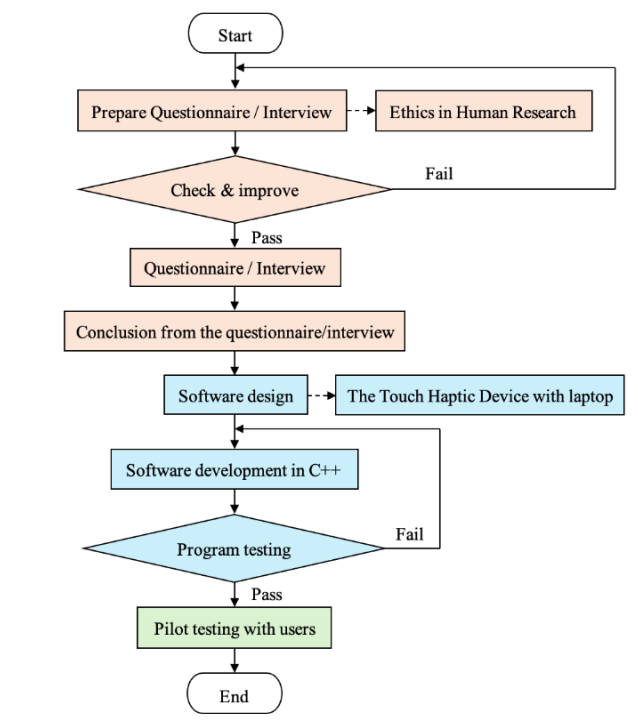Design Requirements for a Haptic-Assisted Hand Motor Training Systems in Stroke Rehabilitation: Insights from a Multidisciplinary Cohort
Keywords:
stroke, rehabilitation, design requirement, motor training system, hapticAbstract
Stroke survivors with disabilities must actively participate in targeted rehabilitation processes to recover their skills and prevent secondary impairments. Haptic technology offers the potential to restore motor functions by integrating visual perception and tactile sensation. However, designing a haptic-assisted hand motor training system for stroke patients poses significant challenges concerning how the program should be developed to achieve the most favorable rehabilitation outcomes. This research aimed to identify the essential design requirements tailored to the unique needs of stroke patients and their care providers, then develop a prototype hand motor training system. A diverse and inclusive cohort was selected for this study. The participants were provided with comprehensive details, ensuring a clear understanding of the objectives. In-depth interviews were conducted to gather valuable insights, which were then summarized and used as the foundation for developing the proposed rehabilitation system. The results highlighted integrating training games with a variety of difficulty levels, and hand-motor functions. The findings provide valuable guidance that could enhance the rehabilitation experience and improve patient outcomes. Moreover, the prototype system developed from these human needs could also be used for real-time measurement, thus facilitating the uncomplicated and rapid evaluation of post-training patients.
References
C. W. Tsao, Heart Disease and Stroke Statistics-2022 Update: A Report from the American Heart Association, vol. 145, no. 8. 2022.
E. S. Donkor, “Stroke in the 21st Century: A Snapshot of the Burden, Epidemiology, and Quality of Life,” Stroke Res. Treat., vol. 2018, 2018, doi: 10.1155/2018/3238165.
N. C. Suwanwela, “Stroke Epidemiology in Thailand,” J. Stroke, vol. 16, no. 1, p. 1, 2014, doi: 10.5853/jos.2014.16.1.1.
C. Samuthpongtorn, T. Jereerat, and N. C. Suwanwela, “Stroke risk factors, subtypes and outcome in elderly Thai patients,” BMC Neurol., vol. 21, no. 1, pp. 1–6, 2021, doi: 10.1186/s12883-021-02353-y.
E. N. Chavan and D. V Rojarkar, “State of art of haptic technology,” vol. 4, no. 01, pp. 118–124, 2017.
S. M. Hatem, “Rehabilitation of motor function after stroke: A multiple systematic review focused on techniques to stimulate upper extremity recovery,” Front. Hum. Neurosci., vol. 10, no. SEP2016, pp. 1–22, 2016, doi: 10.3389/fnhum.2016.00442.
I. Shazhaev, D. Mihaylov, and A. Shafeeg, “A Review of Haptic Technology Applications in Healthcare,” Open J. Appl. Sci., vol. 13, no. 02, pp. 163–174, 2023, doi: 10.4236/ojapps.2023.132013.
M. R. Afzal, H. Y. Byun, M. K. Oh, and J. Yoon, “Effects of kinesthetic haptic feedback on standing stability of young healthy subjects and stroke patients,” J. Neuroeng. Rehabil., vol. 12, no. 1, pp. 1–11, 2015, doi: 10.1186/s12984-015-0020-x.
B. Vollebregt, “The Impact of a Hand Training Programme in Chronic Stroke Survivors: A Qualitative Analysis of Participant Perceived Benefits,” Int. Conf. Virtual Rehabil. ICVR, vol. 2019-July, pp. 5–6, 2019, doi: 10.1109/ICVR46560.2019.8994396.
M. Li, “Attention Enhancement for Exoskeleton-Assisted Hand Rehabilitation Using Fingertip Haptic Stimulation,” Front. Robot. AI, vol. 8, no. May, pp. 1–13, 2021, doi: 10.3389/frobt.2021.602091.
H. Y. Duan, T. Q. Wang, H. H. Lee, and E. Tanaka, “A Wearable Haptic System for Rehabilitation based on the Asymmetric Vibration,” 2021 IEEE/SICE Int. Symp. Syst. Integr. SII 2021, pp. 815–816, 2021, doi: 10.1109/IEEECONF49454.2021.9382748.
V. Valverde-Arredondo and A. Carrasquilla-Batista, “Haptic system for upper limb rehabilitation with hand grip strength measurements and Internet of Things capabilities,” 2020 IEEE 11th Lat. Am. Symp. Circuits Syst. LASCAS 2020, pp. 8–11, 2020, doi: 10.1109/LASCAS45839.2020.9069030.
N. Shah, A. Basteris, and F. Amirabdollahian, “Design Parameters in Multimodal Games for Rehabilitation,” Games for Health Journal, vol. 3, no. 1, 2014, doi: 10.1089/g4h.2013.0044.
C. Yang, Y. Lin, M. Cai, Z. Qian, J. Kivol, and W. Zhang, “Cognitive fatigue effect on rehabilitation task performance in a haptic virtual environment system,” J. Rehabil. Assist. Technol. Eng., vol. 4, p. 205566831773819, 2017, doi: 10.1177/2055668317738197.
S. C. Yeh, S. H. Lee, R. C. Chan, Y. Wu, L. R. Zheng, and S. Flynn, “The Efficacy of a Haptic-Enhanced Virtual Reality System for Precision Grasp Acquisition in Stroke Rehabilitation,” J. Healthc. Eng., vol. 2017, 2017, doi: 10.1155/2017/9840273.
M. Gao, W. Zhang, Z. Qian, and A. Chen, “Automatic Assessment of the Wrist Movement Function in a Haptic Virtual Environment for Home-Based Stroke Rahabilitation,” Can. Conf. Electr. Comput. Eng., vol. 2018-May, 2018, doi: 10.1109/CCECE.2018.8447542.
S. Pareek, P. Chembrammel, and T. Kesavadas, “Development and evaluation of haptics-based rehabilitation system,” 2018 Int. Symp. Med. Robot. ISMR 2018, vol. 2018-Janua, pp. 1–6, 2018, doi: 10.1109/ISMR.2018.8333298.
M. Almousa, H. S. Al-Khalifa, and H. Alsobayel, “Requirements Elicitation and Prototyping of a Fully Immersive Virtual Reality Gaming System for Upper Limb Stroke Rehabilitation in Saudi Arabia,” Mob. Inf. Syst., vol. 2017, 2017, doi: 10.1155/2017/7507940.
D. Auguste-rampersad, G. Medford, and A. Kanneh, “Haptics and Post Stroke Rehabilitation of the Hand,” 2018 IEEE Symp. Comput. Appl. Ind. Electron., pp. 422–427, 2018, doi: 10.1109/ISCAIE.2018.8405510.
M. Zbytniewska et al., “Design and characterization of a robotic device for the assessment of hand proprioceptive, motor, and sensorimotor impairments,” IEEE Int. Conf. Rehabil. Robot., vol. 2019-June, pp. 441–446, 2019, doi: 10.1109/ICORR.2019.8779507.
The TouchTM Haptic Device, 3D Systems, Inc, Oct.2019. [Online]. Available: http://www.3dsystems.com/haptics-devices/touch
Acceleration and jerk calculations, SlowGoing, Nov.2020. [Online]. Available: https://www.physicsforums.com/threads/acceleration-and-jerk-calculations.926721

Downloads
Published
How to Cite
Issue
Section
License

This work is licensed under a Creative Commons Attribution-NonCommercial-NoDerivatives 4.0 International License.








